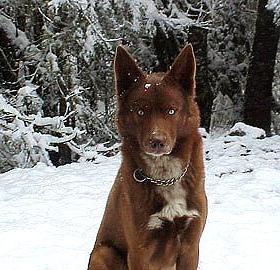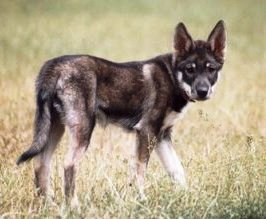Dogs
 By Ruthie Bently
By Ruthie Bently
The American Indian Dog history goes back 30,000 years in both North and South America. They were used by Native American tribes for herding, tracking, corralling bison, running down deer, hunting bear and guarding, as well as pack animals for pulling the travois when a family unit migrated from place to place. Their hair was used for weaving to make garments and blankets. They also kept their owners warm on very cold nights. The breed was developed and strengthened by the breeding of dogs that were traded between tribes of all the Nations from Alaska down into south America by the Plains Indians.
The American Indian Dog is a very intelligent breed. They need a firm, steady owner who is able to be the pack leader so there are no behavior problems. They have strong instincts and need to be socialized well. American Indian Dogs are very conscious of their territory and will bond very strongly to their family members. They are able to adjust to many environments and make exceptional watchdogs of both family and the household. They are cautious and alert around strangers.
 American Indian Dogs are versatile at many jobs, and working is one of their best qualities. They are good at agility, racing, disc dog competitions, as babysitters, in law enforcement, rescue and as certified therapy and certified service dogs.
American Indian Dogs are versatile at many jobs, and working is one of their best qualities. They are good at agility, racing, disc dog competitions, as babysitters, in law enforcement, rescue and as certified therapy and certified service dogs.
Adult males range in size from eighteen to twenty inches and weigh thirty-five to sixty pounds. Females range in size from seventeen to nineteen inches and weigh between thirty and forty-five pounds. They need daily exercise and do well with a long walk. They prefer lots of space but will adjust if given enough exercise and proper training. Their life expectancy is between fourteen and eighteen years. They are a very clean dog; they don’t tend to have much odor and they shed once in the spring.
While the American Indian Dog is not recognized by the American Kennel Club, they are recognized by the American Indian Dog registry (AIDR), the International Indian Dog Owners and Breeders Association (IIDOBA), the Dog Registry of America, Inc. (DRA) and the International Progressive Dog Breeders Alliance (IPDBA).
If you are interested in an American Indian Dog, make sure you do your homework. There are unscrupulous breeders who are passing off wolf and coyote hybrids as Native American Indian Dogs and these are not the same breed. For more information, check the American Indian Dog website or the International Indian Dog Owners and Breeders Association.
Photos courtesy of Song Dog Kennels
Read more articles by Ruthie Bently
- Made In America Dog Breeds
By Linda Cole Most dog breeds originated in other countries and migrated to the United States with immigrants. The most popular dog in the United States is the Labrador Retriever, a breed that hails north of our border in Canada. However, we do have...
- Dog Breed Profile: Newfoundland
By Ruthie Bently The Newfoundland is a member of the American Kennel Club’s Working Group, and they live up to the reputation of a working dog. They are used as draft animals, for search and rescue, for water rescue, as guardians of property and families,...
- Dog Breed Profile: Chinese Crested
By Ruthie Bently The first Chinese Crested I ever met was the hairless variety, and at a distance they look as if they have been shaved to create their distinctive look. The Chinese Crested is known as a good companion dog. They like to play, are alert,...
- Breed Profile: New Guinea Singing Dog
By Ruthie Bently I became aware of a newer “rare breed” of dog recently, when I was asked to write about the New Guinea Singing Dog for this blog. CANIDAE has actually been supporting several New Guinea Singing Dogs at the Tautphaus Zoo in Idaho...
- American Staffordshire Terrier, Breed Profile
The beautiful lady in the picture is my dog, Skye. She is an American Staffordshire Terrier. The American Staffordshire Terrier is a breed that was recognized by the American Kennel Club (AKC) in 1936 and is a member of the Terrier group.According to...
Dogs
Breed Profile: American Indian Dog

The American Indian Dog history goes back 30,000 years in both North and South America. They were used by Native American tribes for herding, tracking, corralling bison, running down deer, hunting bear and guarding, as well as pack animals for pulling the travois when a family unit migrated from place to place. Their hair was used for weaving to make garments and blankets. They also kept their owners warm on very cold nights. The breed was developed and strengthened by the breeding of dogs that were traded between tribes of all the Nations from Alaska down into south America by the Plains Indians.
The American Indian Dog is a very intelligent breed. They need a firm, steady owner who is able to be the pack leader so there are no behavior problems. They have strong instincts and need to be socialized well. American Indian Dogs are very conscious of their territory and will bond very strongly to their family members. They are able to adjust to many environments and make exceptional watchdogs of both family and the household. They are cautious and alert around strangers.

Adult males range in size from eighteen to twenty inches and weigh thirty-five to sixty pounds. Females range in size from seventeen to nineteen inches and weigh between thirty and forty-five pounds. They need daily exercise and do well with a long walk. They prefer lots of space but will adjust if given enough exercise and proper training. Their life expectancy is between fourteen and eighteen years. They are a very clean dog; they don’t tend to have much odor and they shed once in the spring.
While the American Indian Dog is not recognized by the American Kennel Club, they are recognized by the American Indian Dog registry (AIDR), the International Indian Dog Owners and Breeders Association (IIDOBA), the Dog Registry of America, Inc. (DRA) and the International Progressive Dog Breeders Alliance (IPDBA).
If you are interested in an American Indian Dog, make sure you do your homework. There are unscrupulous breeders who are passing off wolf and coyote hybrids as Native American Indian Dogs and these are not the same breed. For more information, check the American Indian Dog website or the International Indian Dog Owners and Breeders Association.
Photos courtesy of Song Dog Kennels
Read more articles by Ruthie Bently
- Made In America Dog Breeds
By Linda Cole Most dog breeds originated in other countries and migrated to the United States with immigrants. The most popular dog in the United States is the Labrador Retriever, a breed that hails north of our border in Canada. However, we do have...
- Dog Breed Profile: Newfoundland
By Ruthie Bently The Newfoundland is a member of the American Kennel Club’s Working Group, and they live up to the reputation of a working dog. They are used as draft animals, for search and rescue, for water rescue, as guardians of property and families,...
- Dog Breed Profile: Chinese Crested
By Ruthie Bently The first Chinese Crested I ever met was the hairless variety, and at a distance they look as if they have been shaved to create their distinctive look. The Chinese Crested is known as a good companion dog. They like to play, are alert,...
- Breed Profile: New Guinea Singing Dog
By Ruthie Bently I became aware of a newer “rare breed” of dog recently, when I was asked to write about the New Guinea Singing Dog for this blog. CANIDAE has actually been supporting several New Guinea Singing Dogs at the Tautphaus Zoo in Idaho...
- American Staffordshire Terrier, Breed Profile
The beautiful lady in the picture is my dog, Skye. She is an American Staffordshire Terrier. The American Staffordshire Terrier is a breed that was recognized by the American Kennel Club (AKC) in 1936 and is a member of the Terrier group.According to...
